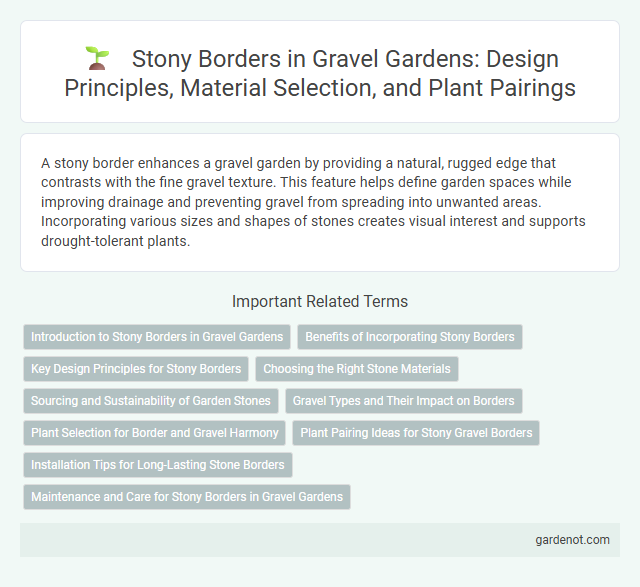A stony border enhances a gravel garden by providing a natural, rugged edge that contrasts with the fine gravel texture. This feature helps define garden spaces while improving drainage and preventing gravel from spreading into unwanted areas. Incorporating various sizes and shapes of stones creates visual interest and supports drought-tolerant plants.
Introduction to Stony Borders in Gravel Gardens
Stony borders in gravel gardens create natural transitions between planting areas and pathways, enhancing both structure and visual interest. These borders use a variety of rocks, ranging from smooth pebbles to rough flagstones, to complement drought-tolerant plants like sedums and lavender. Properly designed stony edges improve drainage and reduce soil erosion, making them ideal for sustainable, low-maintenance garden landscapes.
Benefits of Incorporating Stony Borders
Stony borders in gravel gardens enhance soil drainage, preventing waterlogging and promoting healthy root growth for drought-tolerant plants. These borders also create natural habitat niches for beneficial insects, boosting garden biodiversity. Structurally, stony edges maintain garden layout integrity by reducing soil erosion and controlling gravel spread.
Key Design Principles for Stony Borders
Stony borders in gravel gardens create naturalistic transitions by combining varying sizes of stones with drought-tolerant plants, enhancing both texture and structure. Prioritize layering larger rocks at the base with smaller pebbles and gravel to promote drainage and prevent soil erosion. Incorporating native, low-maintenance species adapted to dry, well-drained conditions ensures long-term sustainability and visual harmony.
Choosing the Right Stone Materials
Selecting the right stone materials for a stony border in a gravel garden ensures durability and aesthetic harmony with the surrounding landscape. Natural stones like granite, sandstone, and limestone offer varied textures and colors that complement gravel while providing structural stability. Consider factors such as local climate, stone porosity, and maintenance requirements to optimize longevity and visual appeal in the garden design.
Sourcing and Sustainability of Garden Stones
Sourcing garden stones from local quarries reduces carbon emissions and supports regional economies, promoting sustainability in gravel garden design. Opting for reclaimed or recycled stones minimizes environmental impact by repurposing materials that would otherwise contribute to landfill waste. Ensuring stones are ethically extracted and transported enhances the ecological balance while maintaining the aesthetic integrity of stony borders in gravel gardens.
Gravel Types and Their Impact on Borders
Stony borders in gravel gardens benefit from selecting specific gravel types such as pea gravel, crushed granite, and river stones, each influencing drainage, texture, and appearance differently. Pea gravel provides smooth drainage and a softer aesthetic, while crushed granite enhances compaction and stability, and river stones introduce natural variation and size contrast. These gravel choices directly impact the border's durability, plant health, and overall garden design harmony.
Plant Selection for Border and Gravel Harmony
Selecting drought-tolerant plants such as lavender, sedum, and ornamental grasses enhances the stony border's texture while thriving in well-drained gravel soil. Incorporating low-growing groundcovers like creeping thyme or stonecrop ensures seamless integration between plants and gravel, promoting both visual appeal and weed suppression. Emphasizing native species adapted to rocky environments maximizes ecological harmony and requires minimal maintenance.
Plant Pairing Ideas for Stony Gravel Borders
Lavender and sedum create a visually striking contrast, thriving in the well-drained soil of stony gravel borders while attracting pollinators. Thyme and dwarf conifers add texture and evergreen interest, enhancing the rugged aesthetic without overwhelming the space. Incorporating ornamental grasses such as blue fescue alongside hardy succulents like sempervivum ensures year-round structure and resilience in harsh, stony conditions.
Installation Tips for Long-Lasting Stone Borders
Ensure a sturdy foundation by excavating a trench at least 6 inches deep and filling it with compacted gravel for optimal drainage. Use landscape fabric beneath the stones to prevent weed growth and stabilize the border's structure. Secure stones tightly together, checking alignment frequently to maintain a uniform and durable edge in your gravel garden.
Maintenance and Care for Stony Borders in Gravel Gardens
Regular inspection and removal of weeds between stones prevent overgrowth and maintain the stony border's clean appearance in gravel gardens. Applying a layer of mulch beneath the stones reduces moisture loss and inhibits weed germination, enhancing durability. Periodic replenishment of gravel ensures an even surface while protecting soil erosion and preserving the structural integrity of the stony border.
Stony border Infographic

 gardenot.com
gardenot.com